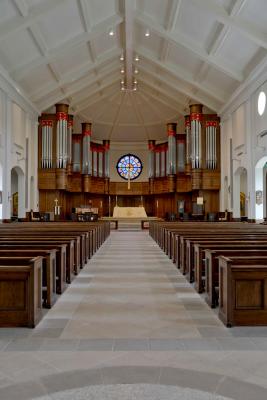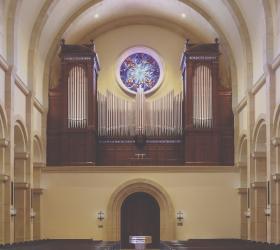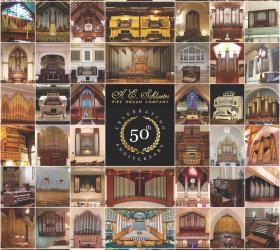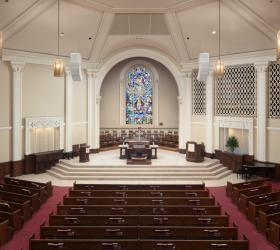
From the builder
Saint George’s Episcopal Church is a vibrant, multi-generational Christian community. The parish ministers to 4,000 members, approximately 1,000 of whom attend one of the five worship services offered every Sunday. It boasts the largest Episcopal kindergarten in the United States, a phenomenal staff of dedicated clergy and laity, and a growth pattern which is a shining light of hope to the wider Church.
The new organ is the final component of a comprehensive visual and acoustical renovation of the primary worship space, which was the capstone of a multi-million-dollar general construction project to serve their growing congregation. The church’s formerly harsh top-heavy acoustics were masterfully transformed by Riedel & Associates to become a beautiful tonal environment: buoyant, lively, clear, and evenly responsive, with a warmth that embraces the most delicate musical nuances. Sound originating in the chancel projects effortlessly to the entire nave.
The chancel’s former configuration forced the choir to sing from a position behind and below a centrally located baldachin. The result was that the choir could neither be heard clearly nor seen by the congregation, and the organist was challenged to find stops soft enough to accompany them. The parish knew something had to be done, and the leadership realized a new organ would be required because of the planned new physical configuration and projected acoustical improvement. The building committee included an organ committee, which auditioned the work of North American and English builders. The Buzard team was selected to build the new instrument because of our well-known passion for sensitive musical expression in the liturgy and how successfully our instruments fulfill both accompanimental and soloistic roles.
It was a joy to develop the unique specification, which includes a great degree of expression. The instrument currently consists of 55 stops/65 ranks. Preparations for planned future additions include six stops in the main organ, and a ten-stop Antiphonal/Ethereal division. Architecturally, the façade was designed in conjunction with architect Baird Dixon, who had envisioned a curved colonnade to outline the apse. The organ’s façade incorporates elements of this concept.
Former rector, the Reverend Dr. Leigh Spruill, commented:
Saint George’s is honored and excited to contract with John-Paul Buzard Pipe Organ Builders for the construction of a magnificent new instrument. The decision for a new organ . . . flows from a strong ongoing commitment to our traditional Anglican liturgical and musical heritage. We are confident a new organ in this space will enhance our experience of worship and are grateful for the privilege of working with Buzard on this project. Worship is our highest priority as Christians, and I give thanks to God again for the generosity of our parishioners who have made possible these dramatic improvements to Saint George’s liturgical life for the future.
In closing, I gratefully acknowledge and thank my team from the bottom of my heart for their tireless efforts, enthusiasm, and beautiful work. This organ’s installation was prolonged by many challenges. Our entire staff (and their spouses back home) accepted and met them with grace and extraordinary patience and effort. I am extremely proud of their outstanding accomplishments in every aspect of this instrument: from the planning and engineering, through the construction, installation, and voicing.
The instrument was first used in worship on Christmas Eve 2022 and first heard in public at a hymn festival led by Robert McCormick on January 27, 2023. The final dedicatory event featuring the Nashville Philharmonic Orchestra was presented on May 9.
—John-Paul Buzard
From the tonal director
The Buzard team always welcomes the opportunity to design and build an organ for institutions that lean heavily toward the performance of English cathedral/collegiate chapel repertoire. In reality, it is perhaps far more accurate to alter that term to “the American interpretation of English Cathedral repertoire.” When some United States choirs are generously welcomed to the UK for week-long residencies in those hallowed spaces that inspired the repertoire, they fall ever more deeply in love with it and strive to bring the mountain-top experience back to their home church completely intact.
The integrity of the repertoire remains constant, but nothing else is the same! The shapes, construction methods, and acoustics of the rooms are vastly different. Worship styles, though always being adapted on both sides of the Atlantic, are fed by very different traditions and heritage. Organbuilders apply their art in a variety of ways to help bridge the gap and let the music live in the new environment. Sometimes it is a virtual reproduction of a much-admired stoplist. Sometimes it is a detailed documentation and copy of the scaling of a particular stop, or even incorporating one or more ranks from an historic organ that has been removed from service.
The Buzard approach, particularly in this organ for Saint George’s, takes some of those techniques into account, but does not stop there. In multiple discussions with Woosug Kang and Gerry Senechal, the outstanding directors of music, we studied specific examples of pieces that highlight their choices of music on a regular basis. Rather than identifying individual stops that would be needed, we concentrated on issues of balance, tone color, composition of critically important accompaniment ensembles, blending, and above all, flexibility.
It has been a rare treat to voice an organ in a revised acoustic environment like Saint George’s. Scott Riedel’s recommendations have provided a room that, without excessive reverberation time, responds with extraordinary evenness throughout the frequency range. This has allowed us to voice the organ with clarity at its softest, building smoothly to a thrilling full-organ sound, without ever needing to exaggerate anything in order to fill the room. We have deliberately concentrated our efforts in shaping the blending characteristics of stops in the mezzo-piano to mezzo-forte range, making choral accompaniment a real joy. Having three separate divisions enclosed and expressive enhances the experience!
The sound of any organ is always the result of many people who have contributed to its design, construction, installation, voicing, and ongoing maintenance. I have often said that our ears are able to detect sounds that have been loved into existence. Along with my colleagues of the Buzard team, we are honored and proud to offer you this gift. Come and hear it for yourself!
—Fredrick Bahr
From the director of music ministries
“Sing ye to the Lord,” from one of the most beloved Easter anthems by the English composer, Edward Bairstow, was the theme of our organ dedication series in the spring of 2023. It reflects our vision of creating an instrument that sings and encourages our choir and congregation to sing whole-heartedly. When Saint George’s Episcopal Church launched its capital campaign several years ago, there was an emphasis on the renovation of the acoustics inside the church and the placement of the choir, because the previous setup presented visual difficulties as well as unbalanced choral sound throughout the room. It also made it difficult for the choir to lead congregational singing. We learned quickly through research that it was in the best interest for the church and the Nashville community to invest in a brand-new organ—it would lead to the most artistically assuring and satisfying result, and it was the most fiscally responsible action for the long-term future.
The organ search committee was quickly formed, with our consultant Scott Riedel supporting us along the way. This was one of the most exhilarating, challenging, and joyful tasks, as we played numerous organs around the country, giving fair evaluations while seeking what we desired. Our mission was to find an organ that would give us the outstanding quality and vast range of expression that would inspire us for generations. I enjoyed working with our search committee, and I am thrilled we chose Buzard Pipe Organ Builders. We have been fulfilling the vision of “Sing ye to the Lord” since our first dedication concert, a hymn festival with guest organist Robert McCormick, and guest speaker Jeremy Begbie. Opus 48 by Buzard, combined with our newly enhanced acoustic, is encouraging our congregation to sing more, and our choir is connected to our congregation while the organ supports them with colorful expressions. We hear the reaction of our congregation, even some who were skeptical of the need for a new organ, vocally responding to us positively about the impact it is making even before the full completion of the organ.
Opus 48 is capable of a wide range of colors and vast range of expression, and I enjoyed showing that in my solo recital in our dedication series in March. The soft and varied flue stops, the fiery reeds that brought music of French Romantic repertoire alive, and the incredible build-up of the organ in music of Herbert Howells all excited me. The softer stops are my favorites on this organ, as the acoustical adjustments now allow the sounds to be distributed evenly, and the individual delicate stops of Opus 48 share many different colors that are unique to their own. I find myself registering for hymns differently Sunday to Sunday as I learn and grow with this new organ, which is a wonderful teacher.
My role here at Saint George’s is to continue to develop the musical legacy I inherited and build an even stronger foundation that future generations of musicians can continue to build on. I believe Buzard Opus 48 is one of the crowning realizations of that vision, along with the acoustical enhancement and the new place for the choir, and I am deeply humbled by this process. I know this organ will serve Saint George’s, its community, and our region with its outstanding craftmanship and artistry for future generations. As I told my choristers, “Some of you will get married with this organ!,” and their smiles as they sing with our new Opus 48 prove that the future is bright.
—Woosug Kang
From the organist
As long as I live, I will never forget the first Sunday we were permitted to use the new organ in worship; though only half the pipework of Opus 48 was installed and voiced at the time, the good people of Buzard correctly judged that there would be enough to support worship. That morning I not only had the opportunity to play but also to sing a bit, and as Woosug concluded the hymn introduction, I became keenly aware that the organ’s sound had involuntarily drawn me toward it in such a way that I absolutely had no choice but to burst into the first stanza. The warmth and support of the organ was like gravity; if I didn’t begin to sing, the rocks themselves may well have! What an incredible, unprecedented feeling.
I was not alone. I immediately noticed that the entire congregation was indeed singing; the contrast from the previous Sunday was night and day! I had expected there to be a great, though surely gradual, increase in congregational song, but I could never have imagined that it would happen in the space of a single hymn introduction. The organ has transformed every hymn it has accompanied since; I have never had a more supported, enabling, and satisfying hymn-singing experience in my life.
In that glorious first moment that morning, the organ fulfilled the aspirations of its design; from the very beginning, the chief purpose of the instrument has been to support Anglican musical worship. The measure of success of any Anglican organ lies in its ability to accompany both the choir and congregation; Opus 48 not only does both beautifully but brings to bear an astonishing array of color—and at any volume. The Swell division features strings at 16′, 8′, and 4′, the Great includes three 8′ Open Diapasons (as the 8′ Dulciana is of Willis disposition, essentially serving as a Third Open), and even the 8′ Clarinet and 16′ English Horn of the Enclosed Great work beautifully in chorus roles. The Pedal 32′ Contra Trombone is both full-length and fully enclosed, allowing it to tastefully reinforce the final chord of a Gloria at Evensong, but can also thunder at full voice at the end of a closing voluntary.
The organ accompanies splendidly but is no retiring wallflower; in addition to the 8′ Cornopean in the Swell, there is also an 8′ Trompette Harmonique that gives white-hot fire to French literature and allows for powerful text-painting in hymns. The splendid Solo Tuba Mirabilis becomes the Ophicleide 16′ in the Pedal, ensuring that there is never a lack of foundation. The Pedal Trombone is playable on the Great as Trombas 16′, 8′, and 4′, all under very effective expression. There are seven 16′ ranks in the manuals alone. The 16′ First Open Diapason in the Pedal lies on its side beneath the rose window, and to quote Fred Bahr, it “owns the real estate.” Even full organ becomes noticeably fuller and more grounded when the Pedal First Open is added! The sound of full organ fills every corner of the room; even in the back pew, one’s entire body senses the pervading warmth and embrace of the organ.
Opus 48 has fundamentally changed how we are able to worship at Saint George’s. I could never adequately express my gratitude for the genius, skill, and love of John-Paul Buzard, Fred Bahr, Felix Franken, Shane Rhoades, Scott Riedel, and Clay Jackson, among many others.
We are happy to welcome any visitors to come play this glorious instrument; please don’t hesitate to be in touch when you are next in Nashville!
—Gerry Senechal
Builder’s website: buzardorgans.com
Church website: www.stgeorgesnashville.org
Photo credit: John-Paul Buzard, except as noted otherwise
MANUAL I – Coupling Manual
GREAT – Manual II
* Enclosed stops
Enclosed Great couples to Manual I at all pitches.
16′ Double Open Diapason (polished tin in façade towers)
16′ Double Dulciana (polished tin in nave-facing façade flats)
16′ Lieblich Gedeckt (wood) *
8′ Open Diapason No. 1 (polished tin in façade)
8′ Open Diapason No. 2 (polished tin in façade)
8′ Dulciana (polished tin in façade)
8′ Bourdon *
8′ Gedeckt Flute (ext Lieblich 16′) *
8′ Flûte Harmonique *
8′ Viola da Gamba *
8′ Viola Celeste (CC) *
4′ Principal
4′ Open Flute *
2-2⁄3′ Twelfth *
2′ Fifteenth
2′ Flauto *
1-3⁄5′ Seventeenth *
1-1⁄3′ Larigot *
1′ Twenty-second *
2′ Fourniture V
1′ Sharp Mixture III *
16′ English Horn *
8′ Trumpet *
8′ Clarinet *
Tremulant *
Tremulant
Cymbalstern
16′ Trombone (Pedal)
8′ Tromba (ext, Pedal)
4′ Tromba Clarion (ext, Pedal)
8′ Tuba Mirabilis (Solo)
8′ Festival Trumpets (horizontal, copper) (preparation)
SWELL – Manual III – Enclosed
16′ Violone (Haskelled)
8′ English Open Diapason
8′ Flauto Traverso (open and harmonic length)
8′ Stopped Diapason (wood and metal)
8′ Salicional
8′ Voix Celeste (CC)
4′ Principal
4′ Harmonic Flute
4′ Violina (ext 16′ Violone)
2-2⁄3′ Nazard
2′ Fifteenth
1-3⁄5′ Tierce
2-2⁄3′ Grave Mixture II
1′ Plein Jeu III
16′ Bassoon (full length)
8′ Trompette Harmonique (Haskelled basses, harmonic at C 25)
8′ Cornopean (English construction)
8′ Oboe (English style, scrolls and lift-lids)
8′ Vox Humana
4′ Clarion (ext 16′ Bassoon)
Tremulant
16′ Trombone (Pedal)
8′ Tromba (ext, Pedal)
4′ Tromba Clarion (ext, Pedal)
8′ Tuba Mirabilis (Solo)
8′ Festival Trumpets (Great, prep)
SOLO – Manual IV – Enclosed
16′ Lieblich Gedeckt (Great)
8′ Grand Open Diapason (double mouths in treble)
8′ Claribel Flute (wood and metal)
8′ Gedeckt Flute (Great)
8′ Viola Pomposa (inverted taper, E. M. Skinner style)
8′ Viola Celeste (CC)
8′ Flûte Cœlestis II (double pipes, single bodies)
8′ Corno di Bassetto (prepared)
8′ Orchestral Oboe (prepared)
8′ Flügel Horn (prepared)
8′ French Horn (prep, high pressure)
8′ Tuba Mirabilis (high pressure)
Tremulant
16′ Trombone (Pedal)
8′ Tromba (ext, Pedal)
4′ Tromba Clarion (ext, Pedal)
8′ Festival Trumpets (Great, prep)
PEDAL
Partially enclosed; in façade and their respective divisions’ boxes
32′ Double Open Diapason (Walker Digital)
32′ Subbass (Walker Digital)
32′ Lieblich Gedeckt (Walker Digital)
32′ Contra Violone (Walker Digital)
16′ Open Diapason No. 1 (wood, large scale)
16′ Open Diapason No. 2 (polished tin, in façade towers) (Great)
16′ Dulciana (Great)
16′ Bourdon (wood)
16′ Violone (Swell)
16′ Lieblich Gedeckt (Great)
8′ Principal (polished tin in façade)
8′ Bass Flute (ext 16′ Bourdon)
8′ Gedeckt Flute (Great)
8′ Salicional (Swell)
8′ Dulcet (Great)
4′ Choral Bass (ext Principal 8′)
4′ Open Flute (ext Bass Flute 8′)
4′ Claribel Flute (Solo)
32′ Contra Trombone (wood and metal, in Great box)
16′ Ophicleide (Solo)
16 Trombone (ext 32′, in Great box)
16 Bassoon (Swell)
16 English Horn (Great)
8 Tromba (ext Trombone 16′)
8 Trumpet
4 Tromba Clarion (ext Trombone 16′)
8 Tuba Mirabilis (Solo)
8 Festival Trumpets (Great, prep)
4 Festival Clarions (Great, prep)
ANTIPHONAL – Floating Enclosed in gallery (prepared)
ANTIPHONAL PEDAL Enclosed (prepared)
(The tonal personality of the Antiphonal is currently under discussion. Ten stops are prepared for, and blank drawknobs have been provided for the speaking stops and couplers.)
Couplers as drawknobs in their respective divisions:
Great to Great 16
Great Unison Off
Great to Great 4
Swell to Swell 16
Swell Unison Off
Swell to Swell 4
Great to Great 16 *
Great Unison Off *
Great to Great 4 *
Solo to Solo 16
Solo Unison Off
Solo to Solo 4
Couplers as tilting tablets, centered in the nameboard, from left to right:
Great to Pedal 8
Great to Pedal 8 *
Swell to Pedal 8
Solo to Pedal 8
Great to Pedal 4
Great to Pedal 4 *
Swell to Pedal 4
Solo to Pedal 4
Swell to Great 8
Solo to Great 8
Solo to Swell 8
Great to Man I 8 *
Swell to Man I 8
Solo to Man I 8
Swell to Great 16
Swell to Great 4
Solo to Great 16
Solo to Great 4
Great to Man I 16 *
Great to Man I 4 *
Swell to Man I 16
Swell to Man I 4
* Couplers for Enclosed Great
Divisional Pistons to Pedal Stops (This tab allows divisional pistons to also operate Pedal stops)
Great as Choir 8. This coupler would transfer the Enclosed Great to Manual I and leave it there to act like a Choir division. It would also turn on the Great Unison Off coupler in the stop jamb so the Enclosed Great does not play on the Great keyboard, creating the semblance of a straight four-manual organ.
Couplers as drawknobs with Antiphonal Speaking Stops
Antiphonal on Man I
Antiphonal on Great
Antiphonal on Swell
Antiphonal on Solo
Antiphonal on Pedal




